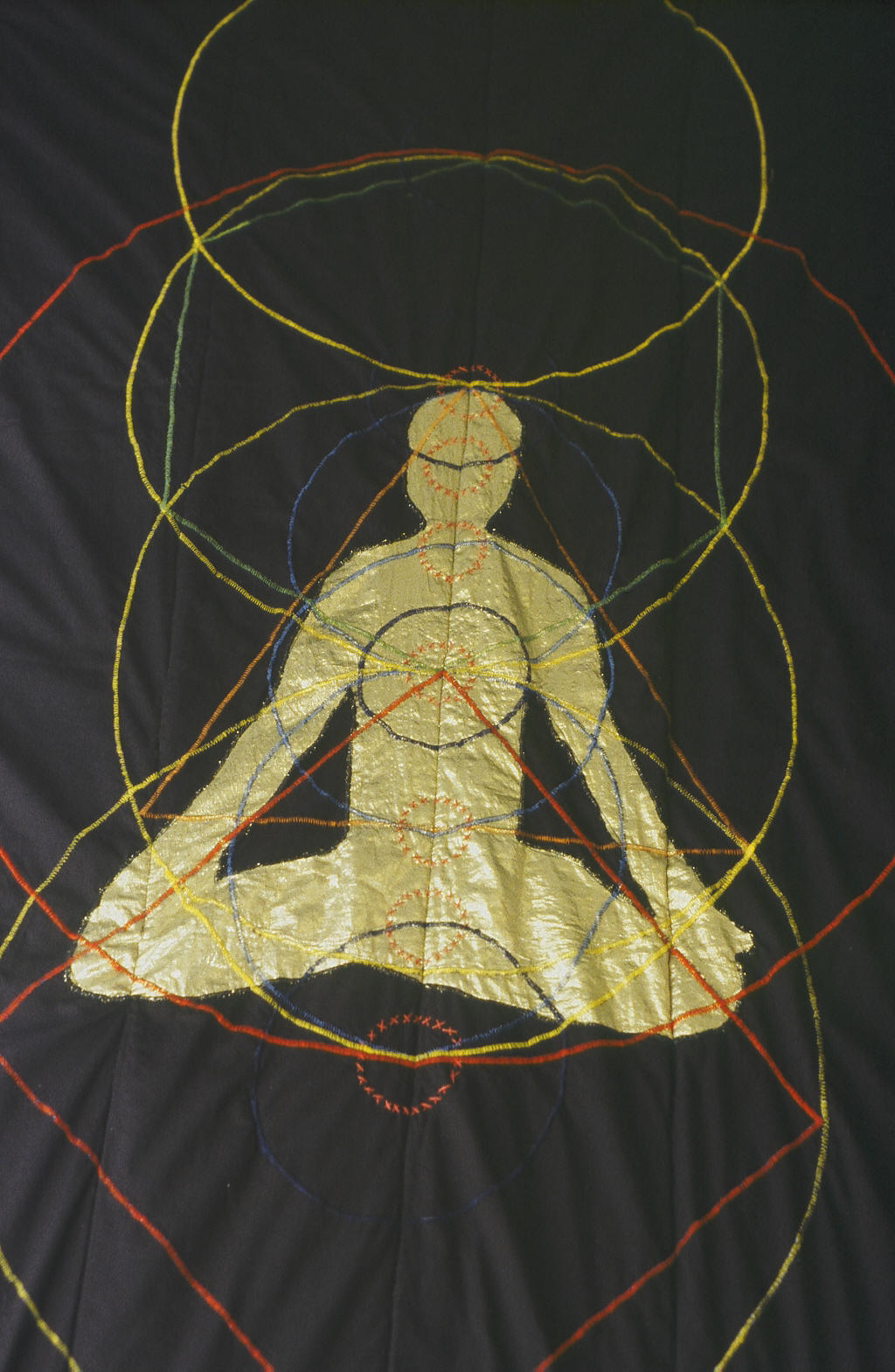
HOME CALENDAR NETWORK FUNDING CONTACT RESOURCE TOURS SACRED GEOMETRY ANTHROPOCOSM EARTH GRID VORTEX SITES SILK ROAD GEOMANCY HARMONICS ANTI-GRAVITY
(See also Cuboctahedron Meridian Model and FIRE SPINDLE)
ANTHROPOCOSM
Psychic Stargate Technology

According to Sumerian cosmology/astrology, the solar system comprises of 12 planetary/celestial bodies, or cosmic notes, influencing 12 zodiac houses; establishing a triangular influence (stars-planets-geo points) upon terrestrial life via Dragon (Knight) Lines [sim.Babylonian: "dragon" (sir); British: title for knight (sir)]. According to Pythagoras, a human being tuned to the cosmos (ie.anthropocosm; conduit between heaven and earth) could hear the music ("rushing sounds") of the planets (cosmos) played through the Earth Grid. Through a larger scope, his pupil, Plato, envisioned the Spindle of Necessity, rotating solar systems (eg.seats for sirens who sing single notes) about the universal axis.
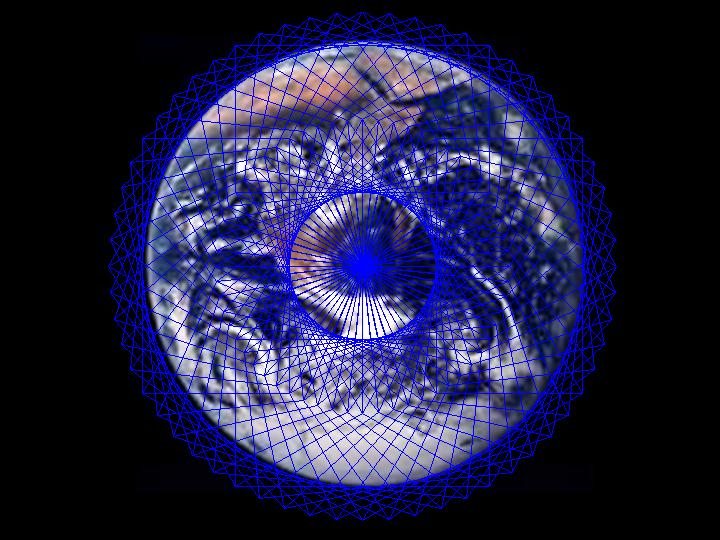
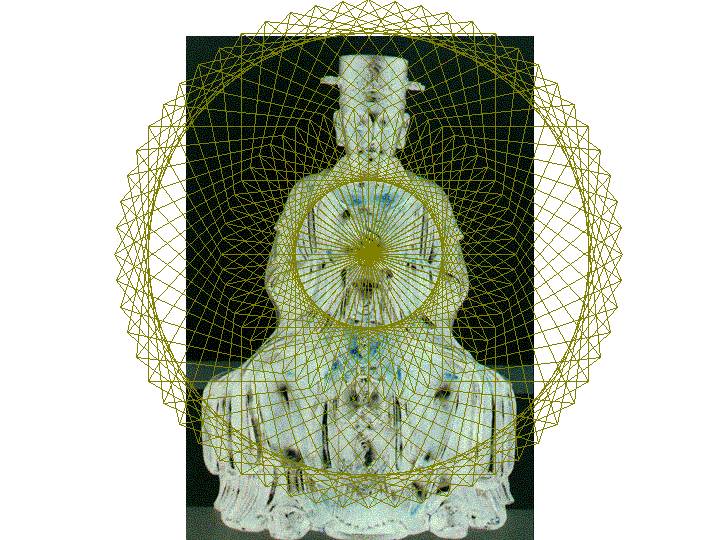
Caduceus: SUMERIAN TREE OF LIFE
Death and Resurrection:
If death was the result of fate rather than destiny, resurrection was possible (eg. Resurrected gods, Marduk, Dumuzi, Ishtar, Baal, Osiris, illustrate the illusion of immortality:). Enki/Ptah bequeathed the divine secrets of life (genetics and biomedicine) and death (resurrection) to �Lord of the Tree/Artifact of Life,� Ningishzida [Egyptian: Thoth; Gk: Hermes], who used his father Enki�s emblem, two entwined serpents [sim.DNA double helix; caduceus] Copper may have been associated in some way with human biogenetics (eg.Enki alternate name, Buzur; copper serpent on Miracle Pole of Moses; copper wash basin at the entrance of the Ark of the Covenant, which was used to prevent death when uttering the name of God in the holy of holies).
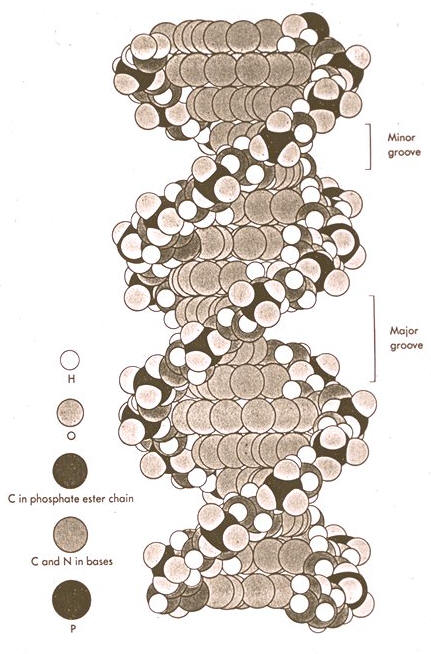

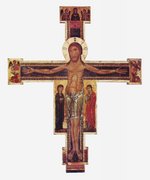
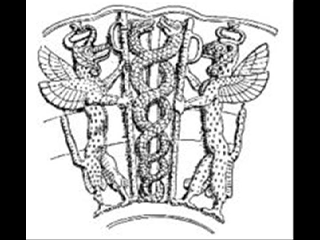

.jpg)
.jpg)
Anthropocosm of the Tree of Life (Kaballah): Axis of the World
The kabballah [Hebrew trans. �to receive� life], tree of life, or divine lightning rod of remote antiquity found in Sumerian mythos (Edin), and Judaic mysticism (kaballah reached its height during the Middle Ages), is a highly definitive axis of the world (axis mundi), or conduit between heaven and earth, which outlines the process of creation as well as the return of manifested phenomena to the source. According to legend, it is a cosmological teaching from the Sumerian King Melchizedek to his faithful servant Abraham. Kabballah can be applied to all phenomena, further defining the processes of the anthropocosm (cosmic human; true human).
The creative process of life begins in the void (ain), or unmanifested consciousness of negative existence, which contains the endlessness of the unknown (ainsoph), which channels limitless light (ainsophaur) through the condensation of the crown (kether) to eventually manifest the physical existence (malcut). Energy descends (divine lightning flash) and ascends [Jacob�s Ladder] the kabballah in a specific path through ten spheres of light, or �brilliances,� (sepherot) (corresponding with the 10 planets of Sumerian cosmology), which are connected through twenty-two pathways [corresponds with 22 letter Hebrew alphabet and Chinese Ganzhi system (10 heavenly stems, 12 earthly branches)]. (Halevi), (Sankey) The sepherot have also been depicted as 10 concentric circles, with the central most inner one designated as the �foundation� (9-yesod) and the most outer being the divine self (1-kether); and beyond is the infinite unknown (ainsoph). When superimposed on the human body, yesod is positioned at the genitals while kether is at the crown.
According to the Book of the Secrets of Enoch, Eden�s Tree of Life �is more beautiful than any created thing; on all sides in appearance is like gold and crimson, transparent as fire.� From its root move four streams of honey, milk, oil, and wine, from Heavenly Paradise to the Paradise of Eden, making a revolution around Earth. This description suggests that the Tree of Life was a conduit between Heaven and Earth, paralleling the Chinese idea of the Kunlun mountains, and the microcosmic orbit functioning as an axis mundi.
On Enoch�s journey to the east beyond deserts and snow peaked mountains in the clouds bordering the Erythraean Sea (modern Arabian Sea and Red Sea), he reached Zotiel, the angel guarding the entrance to Eden. There in the Garden of Righteousness he found the Tree of Knowledge [of good and evil], which was as high as fir, with leaves as of carob, and fruit clustered upon a vine. It was the very tree whose fruits were ingested by Adam and Eve before they were banished.
On Enoch�s journey to the west beyond the mountain range of fire eternally burning, was a place encircled by six mountains separated by deep and rough ravines. In the center was a seventh mountain, which was surrounded by fragrant trees (Tree of Life) of fruit resembling the dates of palms. The middle mountain served as the throne of Holy Great One (Yahweh; El) when He visits Earth.
Its fruit was described in the Ethiopic Book of Enoch, �As for the fragrant tree, no mortal is permitted to touch it till the Great Judgment�Its fruit shall be for food for the elect�Its fragrance shall be in their bones, and they shall live a long life on Earth.�
The fruit of the Tree of Life (Gishtil), which was located in the Western Paradise of Eden parallels the mythological Chinese immortality peaches and mushrooms (lingchi) of the Western Paradise of the Kunlun mountains, where the immortals lived.
According to Jewish legend, the staff of Moses is a magical artifact, known for parting the waters of the Lake of Reeds and healing. Originally a branch of the Tree of Life, Adam brought it out of Eden and gave it to Enoch, who passed it on to his great-grandson Noah. The staff descended the line of Shem to Abraham, the first Hebrew Patriarch. Abraham�s great-grandson, Joseph brought the staff to Egypt, where he rose to the highest rank in the pharaoh�s court. The staff remained as the pharaoh�s treasure, until it reached the hands of Moses, a Egyptian prince before escaping to Sinai.
|
SEPHEROT OF THE KABBALAH |
|||||||||||
|
|
1 |
2 |
3 |
|
4 |
5 |
6 |
7 |
8 |
9 |
10 |
|
Phenomena |
Kether |
Hochma |
Binah |
Daat |
Hesed |
Gevura |
Tepheret |
Netzah |
Hod |
Yesod |
Malcut |
Aspect |
Divine Self |
Wisdom |
Understanding/ Intellect |
Knowledge |
Mercy |
Judgment |
Beauty |
Eternity; Victory |
Reverberation; Splendor |
Foundation |
Kingdom |
|
Anatomy |
Head |
L Brain; L Palm |
R Brain; R Palm |
Head |
L Arm |
R Arm |
Thorax; Viscera |
L Leg |
R Leg |
Genitals |
Root |
|
Viscera |
|
L lung |
R lung |
Brain |
Spleen |
Liver |
Heart |
L kidney yang- vitality |
R kidney yin- truth |
Genitals |
|
Chakra |
Crown |
Third Eye |
Throat |
Heart |
Solar Plexus |
Sacral |
Root |
||||
|
Human |
|
Inner Intellect |
Outer Intellect |
Knowledge |
Inner Emotion |
Outer Emotion |
Essential Nature; Watcher |
Involuntary Processes |
Voluntary Processes |
Persona; Ego |
Body |
|
Psyche |
Divine Self |
Animus; Active Intellect |
Anima; Passive Intellect |
Mystic experience; Prophecy; Enlightenment |
Ego Ideal (reward); Active Emotion |
Super Ego (punishment); Passive Emotion |
Individuality |
Libido; Active Action |
Mortido; Passive Action |
Ego; Identity |
Body; CNS; Id |
|
Planets |
Uranus |
Neptune |
Saturn |
Pluto |
Jupiter |
Mars |
Sun |
Venus |
Mercury |
Moon |
Earth |
|
Earth |
|
Galaxy |
Stars |
Knowledge of Origin |
Sun |
Planets |
Earth |
Nature |
Man |
Moon |
Matter |
|
Government |
|
Spirit of Nation |
Constitution |
Head of State |
Upper House |
Lower House |
Parliament |
Departments |
Civil Service |
People |
Land |
|
Religion |
|
Teaching |
Tradition |
Knowledge |
Momentum Movement |
Discipline Conduct |
|
Practice |
Theory |
Personal Level |
|
|
Economy |
|
Exchange concept |
Finance principles |
Knowledge |
Resources/ Capital |
Banking/ Stock Exchange |
Currency |
Circulation/ Industry |
Trade |
Personal Wealth |
|
|
Life Span In womb; Out of womb
|
|
Father |
Mother; Old age |
Conception |
Cell multiplication; Middle age |
Cell differentiation; Adulthood |
Essence; Prime |
Conservation; ANS; Youth |
Harmonization; Voluntary Systems; Childhood |
Predisposition; Infancy |
Body |
|
Time |
|
Planetary |
Nature |
Non-existence |
Species |
One Life |
Day/Night |
Breath |
Impression |
Passing Time |
Material World |
|
Octave Note |
Do |
Re |
Mi |
Interval |
Fa |
Sol |
Source of Tone |
La |
Ti |
Interval |
Do |
Triads |
|||||||||||
|
|
Monad: Spiritual Triad (1,2,3); Divine Consciousness |
|
Soul Triad; Neshuma: Human Soul (4,5,6); Self Consciousness; Evolution |
Personality Triad; Vegetable Soul (7,8,9) |
Elemental Body: Mineral Soul |
||||||
|
|
Father; Tao |
Son; Yang |
Holy Spirit; Yin |
|
|
|
|
|
|
|
|
|
|
|
Ruah: Spirit; Objective/Cosmic Consciousness (1,2,6) |
|
|
|
|
|||||
|
|
|
|
|
|
|
|
Nefesh: Animal Soul (6,7,8) |
|
|
||
The Four Worlds |
|||||||||||
|
|
Atziluth: Emanations; Fire; Spirit |
|
|
|
|
|
|
|
|
||
|
|
|
Briah: Creation; Air; Intellect; Archetypal |
|
|
|
|
|||||
|
|
|
|
|
|
Yetzirah: Formation; Water; Emotional; Ectypal |
|
|||||
|
|
|
|
|
|
|
|
|
Assiah: Elements and Action; Earth; Physical; Typal |
|||
|
Key: 5% Shade = Right = Actual Left = Pillar of Dynamic = Cosmic Father = Abba = Yang = Energy = Expansion = Freedom = Active/Inner = Pingala nadi (Hindu yang channel) 15% Shade = Left = Actual Right = Pillar of Structure = Cosmic Mother = Aima = Yin = Matter = Contraction = Submission = Passive/Outer = Ida nadi (Hindu yin channel) White = Center = Pillar of Consciousness = Equilibrium = Sushuma (Hindu central channel)
Note: There have been varying sources for the polarity of hochma and binah and pingala and ida. Because pingala and ida were thought to interweave each other, their position really doesn�t matter. Since the Chinese denote the left side of the brain to be the sun (+) and the right side to be the moon (-), the left wrist to be the husband (+) and the right wrist to be the wife (-), I will designate the dynamic pillar (+) and pingala nadi (+) to occupy the left side of the body and the structure pillar (-) and ida nadi (-) to occupy the right side of the body. Ironically the left kidney is yin but occupying netzah (inner action of truth), and the right kidney is yang but occupying hod (outer action of vitality). |
|||||||||||
NEOLITHIC BRITAIN DIVINATION
Neolithic stones (�calcis� which evolved into �calculus� and �calculation�) in the shape of polyhedra (Platonic solids) were made from observing the movement patterns of the stars and planets. Since the planets reside in the heavens, their movement patterns (geometry), and thus the polyhedra are classified as archetypal. It is for this reason that stone polyhedra were used for divination.
Neolithic peoples of Britain used these leather-thonged divination stones at least 1000 years before Plato (according to academia)defined the five elemental polyhedra (aka. Platonic Solids) (Time Stands Still, Keith Critchlow); according to multi-disciplined archeological researchers, Jeffrey Goodman and A.M. Davie, the neolithic polyhedral stones were used as projectile weapons, or bolas(eg.dice), much earlier, c.12,400-20,000 BCE.
The stone faces are defined by leather thongs and marked by a point in the center of each face.


Astronomy, the study of the heavens, recognizes a spherical coordinate geometry. Neolithic inhabitants of Scotland constructed megalithic stone circles (maes howe) and used polyhedral stones (divination dice), as did Plato, Ptolemy, Kepler, and Al-Kindi and the Egyptian Old Kingdom (c.2500 BCE), other pre-Egyptian civilizations (Lucie Lamy), and the Chinese, etc. Therefore, the polyhedral stones could have been 'planning models' that:
1) charted the heavens
2) building calendrical monuments (eg.henges; ziggurats)
3) meteorological studies
4) developed terrestrial maps for predicting major ley lines of telluric energy
and therefore, may have enabled terrestrial or extra-terrestrial travel (ie.anti-gravity, levitation) long ago.
EGYPTIAN COSMOLOGY
In Egyptian mythology, Nun, the cosmic ocean (icosahedron), represents pure undifferentiated spirit, or space without limit of form; preceding any god; it is pure potentiality (the void). By seed or will of the creator, who is within this Nun, the undifferentiated space is impelled to contract and coagulate itself into volume. Thus Atum (Ra), the creator (dodecahedron), first creates himself or distinguishes himself from the undistinguishable Nun by generating volumes, so that creation might begin. (Lawlor)
Creation is distinction or definition. Definition requires the generation of volumes.
GREEK PHILOSOPHY
Plato, the Greek philosopher, who lived approximately 427-347 BC recognized the patterns of the grids. He devised a theory regarding his belief that the earth's basic structure evolved from a simply geometric shape to more complex geometric shapes (cosmological teaching of Pythagoras). These shapes became known as the platonic solids. They are: cube (4), tetrahedron (3), octahedron (8), dodecahedron (12), icosahedron(20).
Plato, in his Timeaus associated each shape with one of the elements, earth, fire, air, ether, and water. The earth's energy grid from the beginnings of its evolutionary course, has evolved through each of these shapes to what it is today. Each shape, superimposed, one upon the other to create a kind of all encompassing energy field that is the very basis of Earth holding it all together.
Plato studied the correlation of four earthly elements and one heavenly element with the properties of the five regular polyhedra, so coined the Platonic solids.
Primitive chaos is described as disorganized trace elements of fire, water, earth, and air. The soul of the cosmos (God), gave them order (shapes). The formation of any volume requires triangulation. (Lawlor) The constructive triangles consist of isosceles (45� triangles) and scalene (30�/60� triangles). Transformation is the break down of a regular solid into its constituent triangles and then the recombination of the triangles to form a different solid. The chaotic elements transformed into the ordered elemental volumes (Platonic solids; polyhedra). Each polyhedron is defined by a certain element depending on its shape and degree of mobility.
Elemental transformation depends on polyhedra in motion ["generative jitterbug" (R. Bucky Fuller); or spinning and pulsing polyhedra that create each other within each other]. Elemental equilibrium depends on polyhedra stillness. Change in size causes change in position. The maintenance of constant disequilibria ensures that the perpetual motion of the constituents (polyhedra) shall continue unceasingly. There is no equilibrium in the original chaos. The volumes express the manifestation of the material world, a process that links heaven with earth. They reenact the cosmic history.
|
ELEMENTAL ASSIGNMENTS FOR THE POLYHEDRA |
|||
|
Polyhedron |
Western/Vedic Element |
Chinese Equivalent Element |
Characteristics |
|
Earthly Elements |
|||
|
Cube |
Earth |
Earth |
Most immobile; made of isosceles triangles |
|
Icosahedron |
Water |
Water |
Least mobile next to the cube; largest; least sharp |
|
Octahedron |
Air |
Metal |
Intermediate mobility; second sharpest |
|
Tetrahedron |
Fire |
Fire |
Most mobile; smallest; sharpest |
|
Heavenly Element |
|||
|
Dodecahedron |
Ether/Space |
Wood |
Least mobile next to icosahedron |
VEDIC/HINDU METAPHYSICS
(According to accepted academia, the Vedas are at least 3500 years old, c.1500 BCE; according to the Vedas themselves, the verbal tradition may date back beyond prehistoric antiquity, and the mythological creation of humanity.)
(see also COSMOLOGY)
Five Envelopes of Consciousness (Pancha Kosa): Elemental Incarnation of Consciousness (Ros), (Feuerstein), (Kshirsagar)
The human being is composed of five envelopes/sheaths of consciousness which increase in a material density as it progresses in depth to the exterior, and so named for their composition. Atma Purusha is covered by the five sheaths (kosas), but remains untouched. During the incarnation of consciousness into life, the subtle envelopes become a generational template of expression for the coarse envelopes. While Vedic (esoteric) anatomy and the Tantras recognizes five envelopes [sim.TCM: spiritual resources of the viscera (zang-fu)], the practice of Ayurveda focuses primarily on the three coarsest (ie.anna, prana, mano), with most emphasis on the most coarse level (anna). [Note: According to the Vedic sciences, in the process of spiritual enlightenment, or the development of self-awareness, the adept attempts to return to the realization of the source of creation by opening consecutive internally progressing envelopes from coarse (earth) to subtle (ether); progressing towards death/pre-birth; sim.Buddhist stupa]. According to the Siddha-Siddhanta-Paddhati, the sheaths of the subtle body consist of six spheres (pinda), which progress from the primordial body (adya pinda) to the embryonic body (garbha pinda), and all being manifestations of divine power (shakti).
Five Envelopes: (from subtle to coarse; inner to outer)
Causal (karanasharira) Body:
1) Bliss (ananda): ether; tantamount to the transcendental self (atman) which sheaths the ultimate reality; (not to be confused with emotional bliss)
Energetic/Astral (sukshmasharira) Body:
2) Wisdom/Knowledge (vijnana/ gyana): metal; the intelligent (higher) mind (buddhi), the seat of wisdom, discerns between reality and illusion in order to invoke certainty, faith and lucid stillness due to its predominance of sattva guna
3) Mind-Emotion (mano): fire; emotional mind; lower functions of the mind (sensory stimulus reception); the mind (manas) driven by desire and doubt, which often causes uncertainty, struggles to externalize consiousness versus withdrawing it into imagination; this movement of consciousness is governed by the factor of inertia (tamas) and dynamism (rajas)
4) Energy/Breath (prana): water; composed of life force, which connects the physical body to the mind; physiological functions (5 vayus)
Gross/Physical (sthulasharira) Body:
5) Food (anna): earth; familiar physical body which navigates in the material realm; organs
According to Ayurveda, a particular envelope of consciousness is nourished, becomes imbalanced, and healed, most directly through the same envelope.
1) Anna kosa: treated by herbs and diet
2) Prana kosa: treated by: [sim.TCM: interaction of metal organs of lung and large intestine]
a) Instantly: breathing (absorbing prana from air) [sim.TCM: clean air energy (qing qi)]
b) Delayed: digestion (absorbing prana through colon) [sim.TCM: grain energy (gu qi)]
3) Mano kosa: treated by words, images, and emotions
However, because the prana kosa (energy) (in which this text primarily focuses on) acts as an intermediary conduit between the anna kosa (body/essence/energy) and mano kosa (mind/spirit), enabling their simultaneous operations, all three envelopes can be treated through the prana kosa alone. [sim.TCM: three treasures (sanbao): essence (jing), energy (qi), spirit (shen)].
Each coarse sheath/envelope of consciousness (ie.anna, prana, mano) has a predominant individual (ahamkara) differentiation, or interdependent perceptual position (gunas), which influences consciousness.
1) Inertia (tamas) stabilizes consciousness through anna kosa
2) Dynamism (rajas) activates consciousness through prana kosa
3) Luminosity (sattva) preserves equilibrium of consciousness through mano kosa
The degree of attention given to a particular envelope, or the quantity of guna, directly relates to the condition of the pertaining envelope, and consequentially consciousness as a whole. Also, the cultivation, or treatment, of the various envelopes should follow a sequence from coarse to subtle, in order to provide the potential support required for energetic phase change. Too much attention on anna kosa (physical body) obstructs tamas creating stubbornness, while too little creates instability. Similarly, the degree of attention to prana kosa affects the quantity of activity. Only through disciplined training (ie.meditation; balancing anna and prana), can the ahamkara fix awareness consistently on mano kosa (mind), where sattva predominates to preserve the equilibrium of consciousness through mediation; otherwise the awareness remains captive within the duality between the curtains of tamas (orthodox stability) and the storms of rajas (innovative change). According to Tantra, the cultivation of anna kosa (eg.Ayurveda) and prana kosa (eg.Hatha Yoga) is required in order to provide the proper stability to the mano kosa (mind).
Metaphysics of Consciousness: Chakra Projections
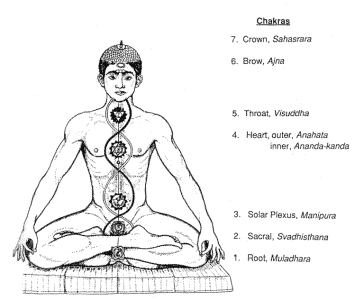
In Hindu metaphysics (mythology), each polyhedron was symbolic of envelopes of consciousness, which were believed to interact with the physical body of man, who is the reenactment of the cosmic history. The whole material coagulation begins with the F seed, the fire spirit (triangulation of form into polyhedral volumes), of the supreme creator, Brahma, analogous to Atum.
Purusha, the cosmic man, is associated with the icosahedron as the seed (bindu) image of Brahma. The icosahedron is the first form that all other forms arise naturally from. It represents the unmanifested potential correlating to the potential wisdom (prana) within the Great Void (sunya). The icosahedron is the only polyhedron that doesn�t touch other polyhedra.
Prakriti, the dodecahedron, represents the feminine power of creation and manifestation (touching all other generated polyhedra). Since the dodecahedron is made up of 12 pentagonal faces, it represents the quintessence of the natural universe; power (shakti).
At the envelope of the natural world, with the star tetrahedron and the octahedron, it is the �2, which is active. The cube (earthly manifestation of unity) of matter is structurally stabilized by the star tetrahedron, which represents the duality within unity. The octahedron, the heart of the cosmic solid, represents the crystallization of matter, which has the clarity of a diamond.
|
POLYHEDRA GENERATION AND ENVELOPES (KOSA) OF CONSCIOUSNESS |
||||||||||
|
* |
Polyhedron |
Element |
OrganZang-fu |
Envelope Kosa |
Seat |
Virtue |
Faces |
Vertexes |
Vectors |
Vector Length |
|
T
|
1 Icosahedron (outer)
|
Water |
K/UB |
Bliss/ Inspiration Ananda |
Meditative Union |
Willfulness |
20 |
12 |
30 |
F |
|
2 Dodecahedron |
Ether/ Space/ Wood |
Lv/GB |
Knowledge VijnanaGyana |
Innate Knowledge by Identity |
Tolerance |
12 |
20 |
30 |
1/�2 |
|
|
3 Cube |
Earth |
Sp/S |
Mind/ Thought Mano |
Pure Reason |
Patience |
6 |
8 |
12 |
1 |
|
|
I
|
4 (Star) Tetrahedron |
Fire |
H/ SI, P/TW |
Energetic Prana |
Intuitive Mental Faculty |
Calmness |
4 |
4 |
6 |
�2 |
|
5 Octahedron |
Air/ Metal |
L/LI |
Food/ Physical Anna |
Instinctual Mind |
Zeal |
8 |
6 |
12 |
1/F |
|
|
1 Icosahedron (inner) |
Water |
|
|
Ultimate Perfection of Body in its Physical Manifestation |
|
|
|
|
1/F2 |
|
|
* = consciousness T = transpersonal I = individual
The last column (Vector Length) is dependent on the radius of the original circle and its division by F.
Note: Each envelope or body of consciousness of the human individual interpenetrates or encompasses the following one. The envelopes may progress from outer to inner in descending order (elementally generative), while the inner is a reflection of the outer (renewing the evolutionary cycle of creation). The first envelope is the causal body (karana sarira; ananda kosa); the second through fourth envelopes (vijnana, mano, and prana) consist of the ethereal /subtle body (linga/sukshma sarira) and the fifth envelope (anna) is the gross material body (sthula sarira). |
||||||||||
(see also Meridian-Point Theory)
Previous information was taken from MARMA SHASTRA: Ayurvedic Bio-Energetics, by Michael Hamilton.
SOUTHEAST ASIAN (VIETNAM; THAILAND) TAOIST GEOMANCY AND ALCHEMY (eg.acupuncture)
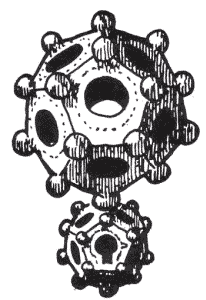
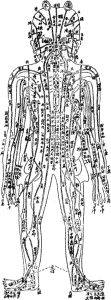
Gold and bronze dodecahedron figures (12 faces/20 horns) that have been unearthed in France and Vietnam, some say depict Laozi's Daodejing, while others recognize them as sacred Taoist alchemical objects marking acupuncture points. Acupuncture is one modality of Taoist Medicine (alchemy).
Ornamental ballistrade at Tianshifu monastery (birthplace of religious Daoism), near Longhushan in China, shows knowledge of the geometry associated with the generation of the elemental polyhedra.
MERIDIANS AND POINTS: Path and Accumulation of Qi
The qi travels on paths called meridians and accumulates in clefts called points. Meridians can be thought of as the energetic (qi) projections of the zang-fu organs having a duty to the shen to become one organ. More specifically, the meridians are projections from the spiritual resources (zhi, hun, shen, yi, po), and supply their houses with jing (essence) and qi. Meridians can be classified by polarity, element, level, anatomical location, or flow type. In fact, meridians are named by the classifications of anatomy, level, and zang-fu organ. All meridians except for the governing and conception vessels are bilateral.
Points may be thought of as cavities, holes, or communication nodes on meridians where the qi travels out and in. Points are typically found near blood vessels in topological recesses or sometimes at meridian crossings. Points can be classified by anatomical location, energetic integrity, and function and indication. It is through the treatment of meridian points where a synergetic effort can be made towards restoring equilibrium.
Meridians and points are summarized according to general meridian functions, meridian count, meridian types, meridian classifications (polar distinctions), meridian relationships, meridian point classifications, horizontal lines of points, body measurement for point location (biometrics), the twelve regular meridians, the eight spiritual vessels, and non-meridian points.
General Meridian Functions: (CAM 55-59)
� Transports qi and blood, and regulates yin and yang
� Resists pathogens and reflects symptoms and signs
� Regulates deficiency and excess conditions
Meridian Count:
|
MERIDIAN COUNT |
||
|
Meridian Type |
Unilateral Number |
Bilateral Number |
|
Regular |
12 |
24 |
|
Branch |
27/ (28) |
52 (54) |
|
Collateral |
15 (16 including stomach) (2 are GV/CV) |
28 (30) |
|
Divergent |
12 |
24 |
Regional |
24 |
48 |
|
Cutaneous |
12 |
24 |
|
Muscular |
12 |
24 |
Spiritual |
8 |
14 |
|
Unilateral |
2 (GV/CV) |
2 |
|
Bilateral |
6 |
12 |
TOTAL |
71 (72) |
138 (140) |
Meridian Types: Specific Meridian Functions
The various meridian types create an intricate web distributing qi and blood throughout the body. Meridians should be thought of as areas of influence rather than lines. There are four types: regular, branch, regional, and spiritual or extraordinary vessels. Regulars are also called primary, and branch and regional are called secondary. Particular meridian types have specific meridian functions.
Regular (internal/external): (Primary)
� Moves qi and blood for nourishment, protection, and zang-fu organ function maintenance
� The connecting, divergent, and spiritual meridians are supplementary branches of the primary channels.
Branch Meridians (via luo-connecting points): (Secondary)
Branch meridians consist of collateral and divergent.
Collateral (Connecting):
� Regular meridian collateral channels are distributed superficially on the four limbs, and the governing and conception vessels are distributed on the anterior and posterior aspects of body
� Govern the surface of the body
� Strengthens and connects internal-external related meridians, maintaining an easy transition in the flow of qi
� Very Minute Connecting Channels: capillary-like channels (very good diagnostic indicators)
� Minute
� Blood
� Superficial
Divergent:
� Regular meridian divergent channels are distributed deep in the body
� Governs the inside of the body
� Connects internal-external related meridians
� Strengthens meridian relationship with the zang-fu organs (meridian extensions)
� Distribute qi to the face and head
� Contains wei qi that acts as a second line of defense against pathogens
Regional Meridians: (Secondary)
Regional meridians consist of cutaneous and muscular.
Cutaneous:
� Distributed superficially in the skin, correlating with the regions of the regular meridians and collaterals (per yin/yang level, and hand/foot classification)
� Distributes qi and blood of the regular meridians to the skin, regulates the pores
� Acts as diagnostic indicator
�Skin is the place where the meridians are distributed. When the pathogen attacks the skin, the sweat pores will open, and the pathogen may advance toward the collaterals, meridians of zang-fu through the sweat pores.� (Su Wen as quoted in CAM 106)
Muscular:
� Distributed deeply in the skin, correlating with the regions of the regular meridians and collaterals (per yin/yang level, and hand/foot classification)
� Travel in depression and planes between muscles and tendons (covering broad surface areas)
� Distributes qi and blood of the regular meridians to nourish the muscles, tendons, and skin, strengthens bone and joint connections, maintains joint flexibility
� Originates from limb extremities (jing-well points) and ascends to the trunk and head
� Knot at joints
� Contains wei qi which acts as the first line of defense against pathogens
� Acts as diagnostic indicator
|
MUSCLE REGION CONNECTIONS |
|||
|
Muscle Region |
Elements |
Connection |
Dantian |
|
Hand Yang |
Fire-Fire-Metal |
Angle of forehead |
Upper |
|
Foot Yang |
Water-Wood-Earth |
Eyes |
Upper |
|
Hand Yin |
Fire-Fire-Metal |
Thoracic cavity |
Middle |
|
Foot Yin |
Water-Wood-Earth |
Genital region |
Lower |
Spiritual Vessels:
� Reservoir of qi and blood (fire and water)
� Draws on the kidney jing: spreads jing throughout entire body; conduit of jing
� Assists circulation of wei qi
Meridian Classifications: Yin and Yang Distinctions (CAM 55-81)
�The means whereby man is created, the means whereby disease occurs, the means whereby man is cured: the twelve meridians are the basis of all theory and treatment.� (Ling Shu as quoted in Mann, Art 35)
Unity represents the eternal matrix of transforming qi. This matrix of energy highways is called the 12 primary meridians and the 8 spiritual vessels in TCM. Depending on the orientation and function of the meridian, they are classified as yin or yang. There are six yin-yang paired regular meridians and four yin and four yang spiritual vessels.
The integrated meridian system of the qi body is synergetic. That is the behavior of the whole is predictable by the behavior of its parts. Synergy represents the integrated behavior of a system. In acupuncture, needling one point can affect the entire qi body.
Polar distinction in meridians can be classified according to anatomical location, six meridians, zang-fu meridian distinction, and spiritual vessel distinction. Polar relationships in meridians are apparent in their qi flows.
Anatomical Location: (Mann, Art 67)
The qi of the yin channels moves outward and upward on the medial aspects of the limbs. The qi of the yang channels moves inward and downward on the lateral aspects of the limbs.
1) Upper Yin: heart, pericardium, and lung become external at the chest and travel down the medial aspect of the arm to the fingertips.
2) Upper Yang: small intestine, triple warmer, and large intestine become external at the fingertips and travel up the lateral aspect of the arm to the face.
3) Lower Yin: spleen, liver, kidney become external at the toes and travel up the medial aspect of the leg, over the abdomen and chest to end near the origin of the upper yin.
4) Lower Yang: stomach, gall bladder, and urinary bladder become external at the head and travel down the body and the lateral aspect of the legs to the toes.
Six Meridians:
Regular meridians can be classified according to the meridian level of febrile disease development. Febrile disease development begins acutely from the external and develops chronically to the internal: taiyang, shaoyang, yangming, taiyin, shaoyin, jueyin (see also differentiation of disease according to the six meridian levels).
� Taiyang: small intestine�urinary bladder
� Yangming: large intestine�stomach
� Shaoyang: triple warmer�gall bladder
� Taiyin: lung�spleen
� Shaoyin: heart�kidney
� Jueyin: pericardium�liver
Meridian Relationships between Qi and Blood: (Mann 53) (see fig. 74.6-8)
The optimum relationship of blood (yin) and qi (yang) quantities depends on the meridian level it exists on. The meridian level or stage of disease correlates with a particular trigram designating a predominant seasonal period. External disease invades first the Taiyang level in the spring and progresses internally (diagrammatically clockwise) to the Jueyin level, which correlates with winter. Generally, blood predominates below the horizontal axis, while qi predominates above.
MERIDIAN LEVEL RELATIONSHIPS OF QI AND BLOOD |
||||
Yang Meridians |
Relationships of Qi and Blood to Meridian Level |
YinMeridians |
||
Yangming(sunlight yang) |
More |
Qi |
More |
Taiyin(greater yin) |
|
More |
Blood |
Less |
||
Shaoyang(lesser yang) |
More |
Qi |
More |
Shaoyin(lesser yin) |
|
Less |
Blood |
Less |
||
Taiyang(greater yang) |
Less |
Qi |
Less |
Jueyin(absolute yin) |
|
More |
Blood |
More |
||
Zang-Fu Meridian Distinction:
There are six yin-yang paired regular meridians.
ZANG-FU MERIDIAN DISTINCTIONS |
|
Yin |
Yang |
|
Lung (L) |
Large Intestine (LI) |
|
Spleen (Sp) |
Stomach (S) |
|
Heart (H) |
Small Intestine (SI) |
|
Kidney (K) |
Urinary Bladder (UB) |
|
Pericardium (P) |
Triple Warmer (TW) |
|
Liver (Lv) |
Gall Bladder (GB) |
Zang-Fu Meridian Qi Flow:
� L-LI-S-Sp-H-SI-UB-K-P-TW-GB-Lv
� yin-yang-yang-yin-yin-yang-yang-yin-yin-yang-yang-yin
Spiritual (Extraordinary) Vessels Distinction: (Matsumoto)
There are four yin and four yang spiritual vessels.
|
VESSEL POLAR DISTINCTIONS |
|
Yin |
Yang |
|
Ren (Conception) |
Du (Governing) |
|
Chong (Penetrating) |
Dai (Girdle) |
|
Yinwei (Yin-linking) |
Yangwei (Yang-linking) |
|
Yinqiao (Yin-heel) |
Yangqiao (Yang-heel) |
Spiritual Vessel Coupled Qi Flow:
� Chong (father) � Yinwei (mother)
� Dai (male) � Yangwei (female)
� Du (husband) � Yangqiao (wife)
� Ren (master) � Yinqiao (guest)
Kinetic (yang) � Potential (yin) of Spiritual Vessels: respective of above
� yin � yin
� yang � yang
� yang � yang
� yin � yin
Previous information was taken from ACUSOURCE: The Acupuncture Handbook, by Michael Hamilton.
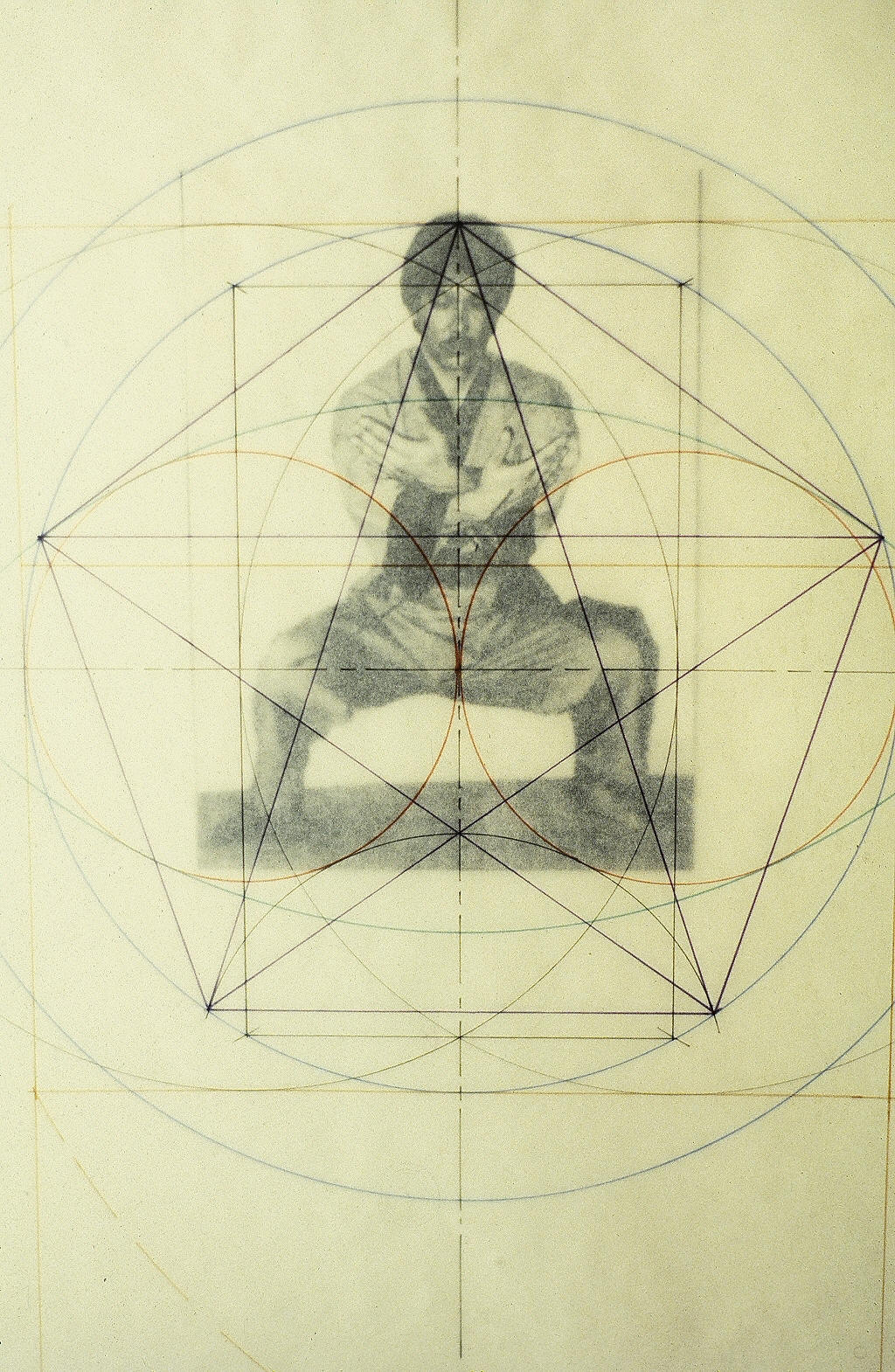
(see also Cuboctahedron Meridian Model)